Microsoft Entra single sign-on (SSO) integration with Salesforce Sandbox
In this tutorial, you'll learn how to integrate Salesforce Sandbox with Microsoft Entra ID. When you integrate Salesforce Sandbox with Microsoft Entra ID, you can:
- Control in Microsoft Entra ID who has access to Salesforce Sandbox.
- Enable your users to be automatically signed-in to Salesforce Sandbox with their Microsoft Entra accounts.
- Manage your accounts in one central location.
Prerequisites
To get started, you need the following items:
- A Microsoft Entra subscription. If you don't have a subscription, you can get a free account.
- Salesforce Sandbox single sign-on (SSO) enabled subscription.
Scenario description
In this tutorial, you configure and test Microsoft Entra single sign-on in a test environment.
- Salesforce Sandbox supports SP and IDP initiated SSO
- Salesforce Sandbox supports Just In Time user provisioning
- Salesforce Sandbox supports Automated user provisioning
Adding Salesforce Sandbox from the gallery
To configure the integration of Salesforce Sandbox into Microsoft Entra ID, you need to add Salesforce Sandbox from the gallery to your list of managed SaaS apps.
- Sign in to the Microsoft Entra admin center as at least a Cloud Application Administrator.
- Browse to Identity > Applications > Enterprise applications > New application.
- In the Add from the gallery section, type Salesforce Sandbox in the search box.
- Select Salesforce Sandbox from results panel and then add the app. Wait a few seconds while the app is added to your tenant.
Alternatively, you can also use the Enterprise App Configuration Wizard. In this wizard, you can add an application to your tenant, add users/groups to the app, assign roles, as well as walk through the SSO configuration as well. Learn more about Microsoft 365 wizards.
Configure and test Microsoft Entra SSO for Salesforce Sandbox
Configure and test Microsoft Entra SSO with Salesforce Sandbox using a test user called B.Simon. For SSO to work, you need to establish a link relationship between a Microsoft Entra user and the related user in Salesforce Sandbox.
To configure and test Microsoft Entra SSO with Salesforce Sandbox, perform the following steps:
- Configure Microsoft Entra SSO - to enable your users to use this feature.
- Create a Microsoft Entra test user - to test Microsoft Entra single sign-on with B.Simon.
- Assign the Microsoft Entra test user - to enable B.Simon to use Microsoft Entra single sign-on.
- Configure Salesforce Sandbox SSO - to configure the single sign-on settings on application side.
- Create Salesforce Sandbox test user - to have a counterpart of B.Simon in Salesforce Sandbox that is linked to the Microsoft Entra representation of user.
- Test SSO - to verify whether the configuration works.
Configure Microsoft Entra SSO
Follow these steps to enable Microsoft Entra SSO.
Sign in to the Microsoft Entra admin center as at least a Cloud Application Administrator.
Browse to Identity > Applications > Enterprise applications > Salesforce Sandbox > Single sign-on.
On the Select a single sign-on method page, select SAML.
On the Set up single sign-on with SAML page, click the pencil icon for Basic SAML Configuration to edit the settings.
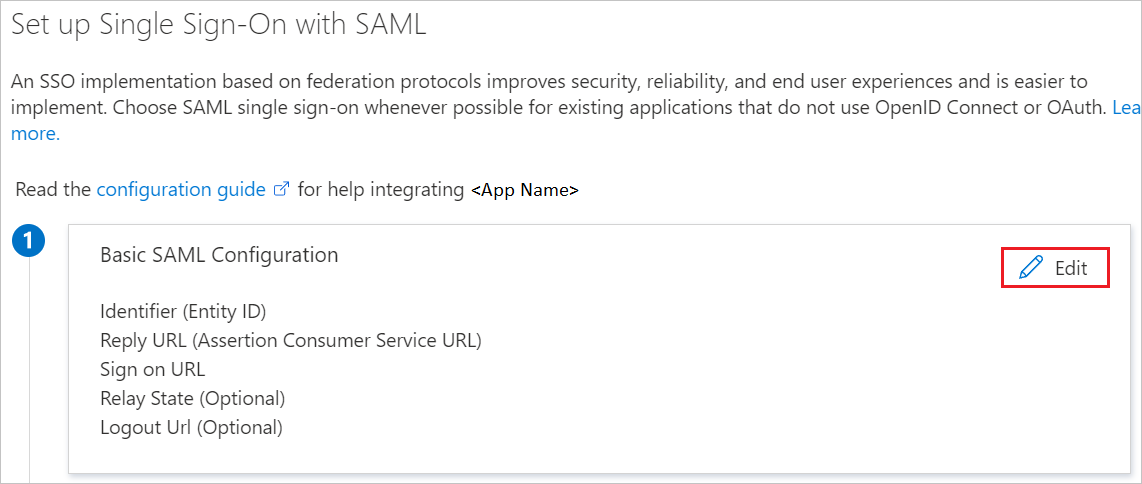
On the Basic SAML Configuration section, if you have Service Provider metadata file and wish to configure in IDP initiated mode perform the following steps:
a. Click Upload metadata file.

b. Click on folder logo to select the metadata file and click Upload.

Note
You will get the service provider metadata file from the Salesforce Sandbox admin portal which is explained later in the tutorial.
c. After the metadata file is successfully uploaded, the Reply URL value will get auto populated in Reply URL textbox.

Note
If the Reply URL value do not get auto populated, then fill in the value manually according to your requirement.
On the Set up Single Sign-On with SAML page, in the SAML Signing Certificate section, click Download to download the Metadata XML from the given options as per your requirement and save it on your computer.

On the Set up Salesforce Sandbox section, copy the appropriate URL(s) as per your requirement.

Create a Microsoft Entra test user
In this section, you'll create a test user called B.Simon.
- Sign in to the Microsoft Entra admin center as at least a User Administrator.
- Browse to Identity > Users > All users.
- Select New user > Create new user, at the top of the screen.
- In the User properties, follow these steps:
- In the Display name field, enter
B.Simon. - In the User principal name field, enter the username@companydomain.extension. For example,
B.Simon@contoso.com. - Select the Show password check box, and then write down the value that's displayed in the Password box.
- Select Review + create.
- In the Display name field, enter
- Select Create.
Assign the Microsoft Entra test user
In this section, you'll enable B.Simon to use single sign-on by granting access to Salesforce Sandbox.
- Sign in to the Microsoft Entra admin center as at least a Cloud Application Administrator.
- Browse to Identity > Applications > Enterprise applications > Salesforce Sandbox.
- In the app's overview page, select Users and groups.
- Select Add user/group, then select Users and groups in the Add Assignment dialog.
- In the Users and groups dialog, select B.Simon from the Users list, then click the Select button at the bottom of the screen.
- If you are expecting a role to be assigned to the users, you can select it from the Select a role dropdown. If no role has been set up for this app, you see "Default Access" role selected.
- In the Add Assignment dialog, click the Assign button.
Configure Salesforce Sandbox SSO
Open a new tab in your browser and sign in to your Salesforce Sandbox administrator account.
Click on the Setup under settings icon on the top right corner of the page.
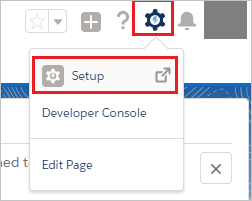
Scroll down to the SETTINGS in the left navigation pane, click Identity to expand the related section. Then click Single Sign-On Settings.
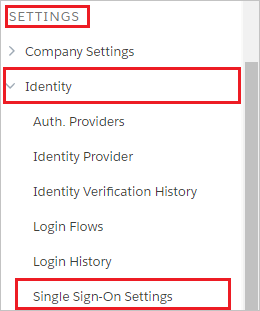
On the Single Sign-On Settings page, click the Edit button.

Select SAML Enabled, and then click Save.

To configure your SAML single sign-on settings, click New from Metadata File.

Click Choose File to upload the metadata XML file which you have downloaded and click Create.

On the SAML Single Sign-On Settings page, fields populate automatically and click save.
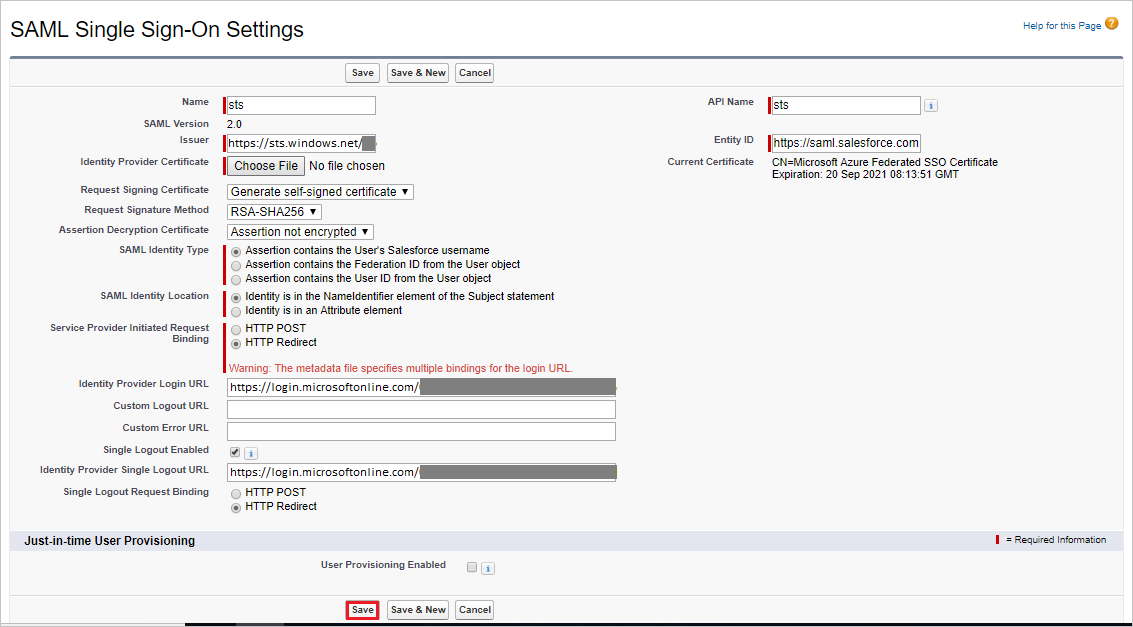
On the Single Sign-On Settings page, click the Download Metadata button to download the service provider metadata file. Use this file in the Basic SAML Configuration section in the Azure portal for configuring the necessary URLs as explained above.
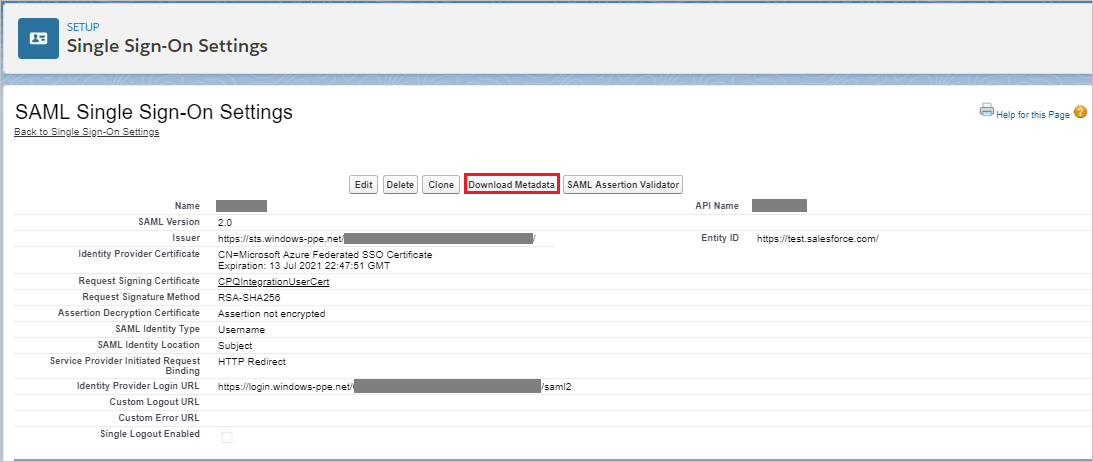
If you wish to configure the application in SP initiated mode, following are the prerequisites for that:
a. You should have a verified domain.
b. You need to configure and enable your domain on Salesforce Sandbox, steps for this are explained later in this tutorial.
c. In the Azure portal, on the Basic SAML Configuration section, click Set additional URLs and perform the following step:

In the Sign-on URL textbox, type the value using the following pattern:
https://<instancename>--Sandbox.<entityid>.my.salesforce.comNote
This value should be copied from the Salesforce Sandbox portal once you have enabled the domain.
On the SAML Signing Certificate section, click Federation Metadata XML and then save the xml file on your computer.

Open a new tab in your browser and sign in to your Salesforce Sandbox administrator account.
Click on the Setup under settings icon on the top right corner of the page.

Scroll down to the SETTINGS in the left navigation pane, click Identity to expand the related section. Then click Single Sign-On Settings.

On the Single Sign-On Settings page, click the Edit button.

Select SAML Enabled, and then click Save.

To configure your SAML single sign-on settings, click New from Metadata File.

Click Choose File to upload the metadata XML file and click Create.

On the SAML Single Sign-On Settings page, fields populate automatically, type the name of the configuration (for example: SPSSOWAAD_Test), in the Name textbox and click save.
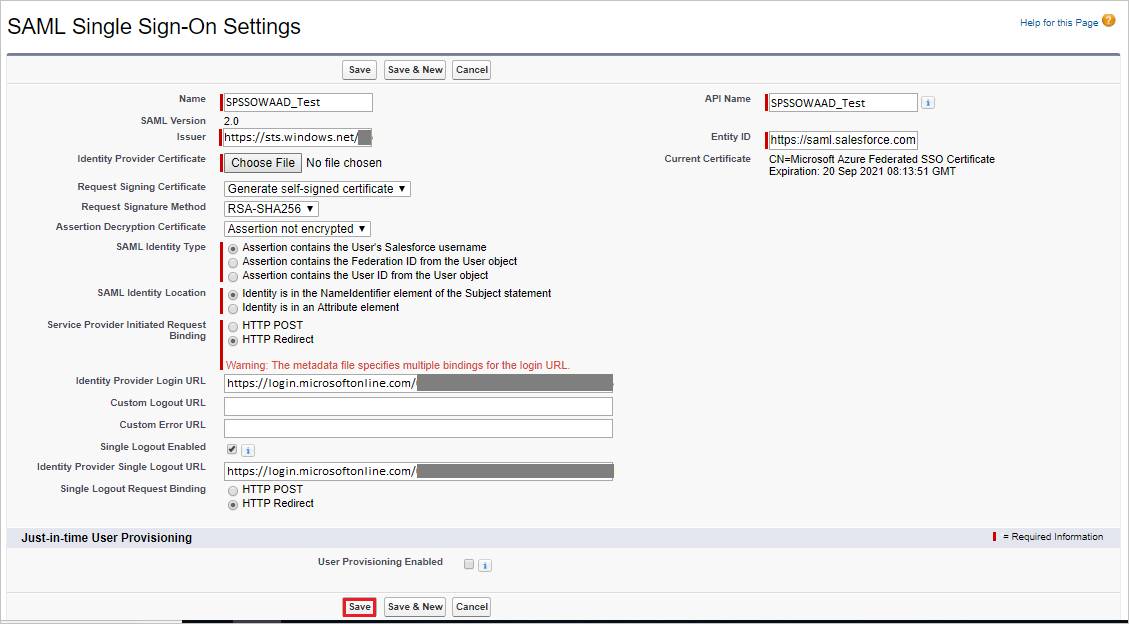
To enable your domain on Salesforce Sandbox, perform the following steps:
Note
Before enabling the domain you need to create the same on Salesforce Sandbox. For more information, see Defining Your Domain Name. Once the domain is created, please make sure that it's configured correctly.
On the left navigation pane in Salesforce Sandbox, click Company Settings to expand the related section, and then click My Domain.

In the Authentication Configuration section, click Edit.
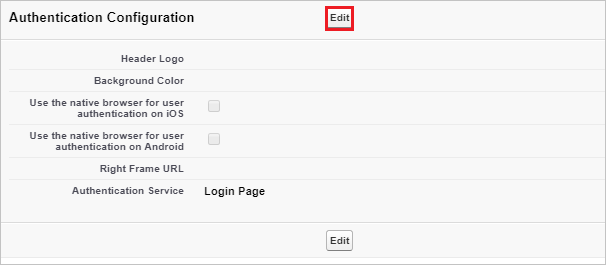
In the Authentication Configuration section, as Authentication Service, select the name of the SAML Single Sign-On Setting which you have set during SSO configuration in Salesforce Sandbox and click Save.
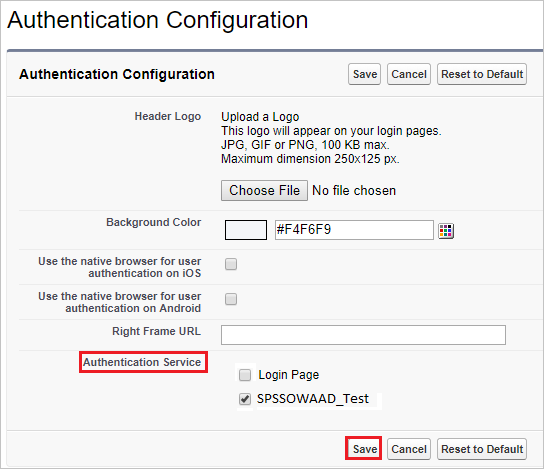
Create Salesforce Sandbox test user
In this section, a user called Britta Simon is created in Salesforce Sandbox. Salesforce Sandbox supports just-in-time provisioning, which is enabled by default. There is no action item for you in this section. If a user doesn't already exist in Salesforce Sandbox, a new one is created when you attempt to access Salesforce Sandbox. Salesforce Sandbox also supports automatic user provisioning, you can find more details here on how to configure automatic user provisioning.
Test SSO
In this section, you test your Microsoft Entra single sign-on configuration with following options.
SP initiated:
Click on Test this application, this will redirect to Salesforce Sandbox Sign on URL where you can initiate the login flow.
Go to Salesforce Sandbox Sign-on URL directly and initiate the login flow from there.
IDP initiated:
- Click on Test this application, and you should be automatically signed in to the Salesforce Sandbox for which you set up the SSO
You can also use Microsoft My Apps to test the application in any mode. When you click the Salesforce Sandbox tile in the My Apps, if configured in SP mode you would be redirected to the application sign on page for initiating the login flow and if configured in IDP mode, you should be automatically signed in to the Salesforce Sandbox for which you set up the SSO. For more information about the My Apps, see Introduction to the My Apps.
Related content
Once you configure the Salesforce Sandbox you can enforce session controls, which protects exfiltration and infiltration of your organization’s sensitive data in real time. Session controls extends from Conditional Access. Learn how to enforce session control with Microsoft Defender for Cloud Apps.